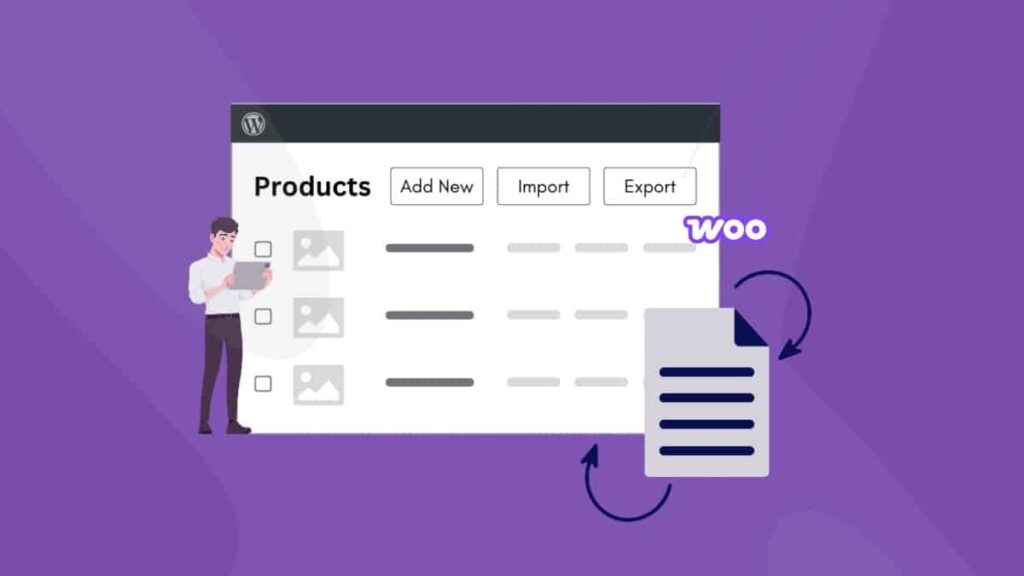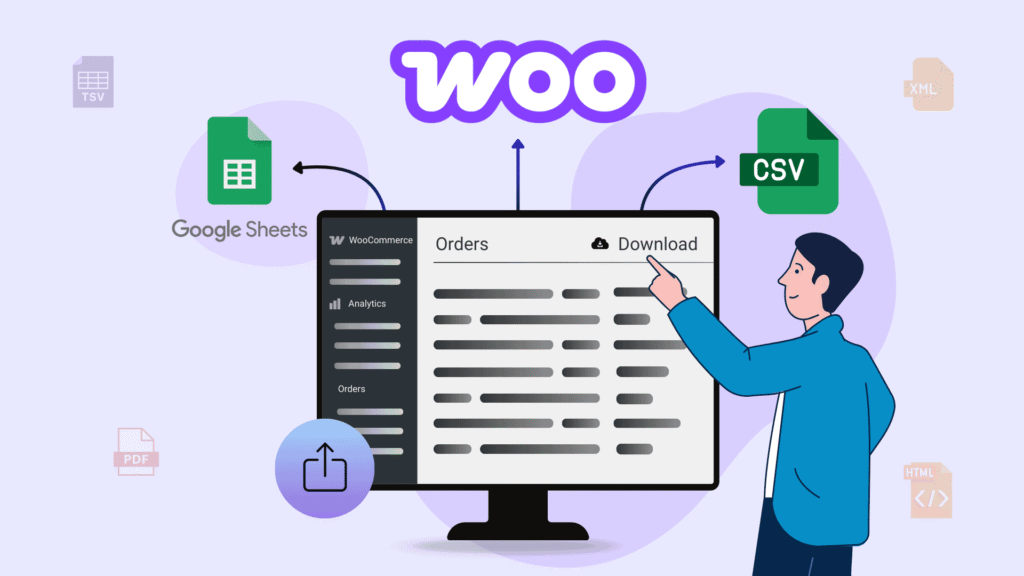Managing a WooCommerce store can be a complicated task for store owners, especially when dealing with a large number of products. One of the most crucial aspects of this management is the ability to import and export WooCommerce products efficiently.
With WooCommerce’s import and export features, you can move products between stores, back up your catalog, or bulk update product details — all without coding or expensive tools.
In this guide, we’ll explain how to export existing products, import new ones (or update current ones), and even upload custom CSV files. By the end, you’ll know how to simplify your inventory management and save hours of manual work.
Let’s get started!
Key Takeaways
- Learn how to bulk export and import WooCommerce products in just a few clicks.
- Discover the best ways to migrate products, update inventories, and set up demo stores.
- Explore how CSV files help you manage product data safely and efficiently.
- Find out how to avoid common import/export mistakes and keep your store running smoothly.
Why You Should Import and Export WooCommerce Products
When managing a WooCommerce store, there are various benefits where importing and exporting products become essential. Here are some common benefits:
- Save Time: Bulk updating and migrating products can significantly reduce the time spent on manual entry. Instead of updating each product individually, you can export your entire product catalog, make necessary changes in a CSV file, and re-import it.
- Keep Data Safe: Regularly exporting your WooCommerce products serves as a backup. In case of data loss or site issues, you can quickly restore your products from the export file, minimizing downtime and data loss.
- Seamless Migrations: When transitioning from one website to another, importing and exporting WooCommerce products ensures that all product data is accurately transferred without manual re-entry.
- Updating Inventory: For businesses with large inventories, exporting products for inventory management and then re-importing updated files helps keep stock levels accurate.
- Setting Up a Demo Store: When setting up a demo store for your needs or for a client, importing products from a standard or previous setup allows for a quick and consistent demonstration environment.
What are the Common Mistakes During Import & Export WooCommerce Products
While WooCommerce makes it easy to import and export products, a few common mistakes can cause the process to fail or produce unexpected results. Here are some typical issues you might encounter and how to avoid them:
Incorrect CSV Format
One of the most common issues during import is using a CSV file that doesn’t follow WooCommerce’s required structure. For example:
- Missing column headers
- Incorrect delimiters (use commas instead of semicolons)
- Improper encoding (should be UTF-8)
Solution: Use WooCommerce’s sample CSV as a template and ensure your file is saved in UTF-8 format.
Missing Required Fields
Certain fields like Product ID, SKU, or Product Name are important for WooCommerce to recognize and process the product. If these are missing or empty, the product may not be imported or updated correctly.
Solution: Always fill out key fields like SKU, name, and type, especially when updating existing products.
Image Import Issues
If the image URLs in the CSV are broken, incorrect, or point to a non-public server, WooCommerce won’t be able to download and attach them to products.
Solution: Double-check image URLs and ensure they’re accessible on the internet.
Large CSV Files Timing Out
If your CSV file contains hundreds or thousands of products, the import may fail due to server timeout or memory issues.
Solution: Split your CSV file into smaller chunks or consider increasing server timeout and memory limits.
Unintended Product Duplication
If product IDs or SKUs don’t match existing products, WooCommerce will treat them as new entries, resulting in duplicate listings.
Solution: Double-check product IDs or SKUs if you’re updating existing products, and ensure you check the “Update existing products” option.
How to Import and Export WooCommerce Products
WooCommerce has an in-built feature that lets you easily import and export products without extra plugins. Below, we’ll explain how you can import and export WooCommerce products.
Export WooCommerce Products
To effortlessly export your WooCommerce products, follow these straightforward steps. First, ensure you’ve already added all your products to your online store. Exporting allows you to save all your product data into a file that you can keep as a backup or use for various purposes. This step ensures that you have a complete record of your products handy whenever you need it.
- Navigate to WordPress Dashboard ➝ Products ➝ All Products.
- Then, click the “Export” button at the top of the product list. It will take you to the export settings.
- You can choose which columns to export, such as product IDs, titles, prices, etc., and select specific product types or categories to include. If you want to export all products from your store, leave all the options blank.
- After setting up your preferences, click the “Generate CSV” button. Your products will be exported into a CSV file, which you can save to your system.
What are the Different Methods to Import WooCommerce Products
There are several easy ways to import products into your WooCommerce store. Below, we’ll look at different methods you can use without any plugins, helping you find the best option for your needs:
Method 1: Importing WooCommerce Products
This is the easiest way WooCommerce allows you to import products from online stores. After exporting your products, you can use that data to import them into any store. To do this, follow these steps:
- Navigate to WordPress Dashboard ➝ Products ➝ All Products.
- Here, you will see an option to Import; click on that to access the import settings.
- Next, upload the CSV file that you exported earlier and click Continue.
- Then, you’ll need to map the CSV data to the existing WooCommerce product fields. The default settings usually work for most stores, so you can leave them as they are or review the fields. Finally, click the Run Importer button.
- Then, WooCommerce will start importing your product data from the CSV file and download any product images linked to your items.
Method 2: Import Your Own CSV Sample File
In this section, we’ll explain how to upload your sample product CSV file to a WooCommerce store. If you’re working on a client’s store and want to showcase a demo with specific products, you can easily upload your data as products in WooCommerce. To do this, you must create a CSV file that includes all the necessary product details.
WooCommerce also provides a sample product file with a specific structure you should follow when you install the plugin. To see this structure, go to the following directory: app/public/wp-content/plugins/woocommerce/sample-data Here, you’ll find the sample product files. Open it and review the structure of the files.
Once you’ve understood the structure and created your own CSV file, you can import it into your WooCommerce store. Navigate to the Products section and follow the steps we discussed earlier to complete the import process.
How to Update Your Existing WooCommerce Products
You can easily update existing products in your WooCommerce store with new information, like brands or sale events. To do this, create a CSV file containing the latest details for each product you want to update. Ensure to include the product IDs or SKUs in your CSV file so WooCommerce can match them with the products in your store. Then, follow the same process you use to import products into your store.
When you import, you’ll see an option to update existing products—be sure to check that box. If the product IDs in your CSV match those in your store, WooCommerce will update those products. If they don’t match, it will create new products instead. This way, you can keep your product information up to date quickly.
Manage Your WooCommerce Products Easily
Importing and exporting WooCommerce products is a vital process for managing your online store efficiently. Whether you need to migrate products, update information, or create backups, this process simplifies your workflow and saves you time.
Following the steps outlined in this article, you can ensure your product data remains organized and up-to-date. With the right approach, managing your inventory becomes much easier, allowing you to focus on growing your business and enhancing your customers’ shopping experience.
FAQs on Import and Export WooCommerce Products
How to export WooCommerce products?
– Go to WordPress Dashboard → Products → All Products, then click the Export button.
– Choose the data you want to export (e.g., product type, category, fields) and click Generate CSV.
– This will download a file with your product information.
How do I import products into WooCommerce?
– Go to WordPress Dashboard → Products → All Products, then click the Import button.
– Upload your CSV file, map the fields if necessary, and click Run Importer.
– WooCommerce will process the file and import the product data.
What file format does WooCommerce use for import/export?
WooCommerce uses CSV (Comma-Separated Values) files for both importing and exporting products.
Can I choose specific products or categories to export?
Yes, during export, you can select particular product types, categories, or even individual fields (like SKU, price, etc.).
Where can I find a sample CSV file for importing products?
WooCommerce provides sample files in the plugin directory: /wp-content/plugins/woocommerce/sample-data
Can I import products from another WooCommerce store?
Yes! Export products from one site, then import the CSV into your new store to migrate products easily.



